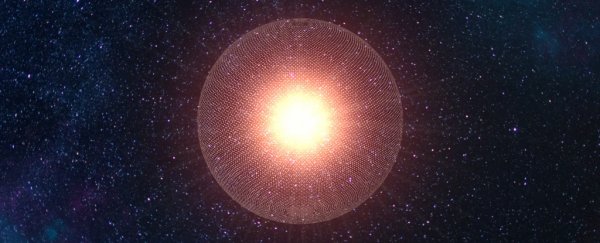Once again, scientists have scrutinised one of the strangest stars in the sky to understand its wild light fluctuations.
The latest observations of KIC 8462852, also known as Tabby's star or Boyajian's star, have scanned for the kind of laser emission that could be produced by a civilisation. Well, guess what.
It's been three-and-a-half years since the discovery of KIC 8462852 was announced, and the way it dims and shines seemingly at random has proven a puzzle for astronomers.
In fact, it's so vexatious that one initial explanation involved "an alien megastructure" as the cause of these seemingly unnatural fluctuations.
The nickname of "alien megastructure star" stuck, but the explanation didn't. It was thrown out last year after analysis determined that some wavelengths of light were blocked more than others - which wouldn't be the case if a structure was doing the blocking.
Other hypotheses have included a ringed planet passing in front of the star, either absolutely enormous or a smaller one with an orbital wobble; a swarm of comets; space junk; the star swallowing a planet; something happening inside the star itself; and the scientific equivalent of a shrug emoji.
But astronomers are anything if not thorough. A team from UC Berkeley SETI, led by then high-school student David Lipman (now at Princeton), approached the star from a previously unexplored angle.
Their results have now been uploaded to pre-print server arXiv ahead of peer review, and they're certainly interesting.
"We analyse 177 high-resolution spectra of Boyajian's Star in an effort to detect potential laser signals from extraterrestrial civilisations," the researchers wrote in their paper.
Using data from the Lick Observatory's Automated Planet Finder telescope, the team looked for continuous laser light more powerful than 24 megawatts. That's the lower limit of power detectable by the telescope at 1,470 light-years away - the distance to KIC 8462852.
This power level is within the capabilities of human technology. So if a civilisation at least as advanced as humanity was out there, it might have lasers, and it might be using them in a way that we could see them.
So, the team combed data from the telescope. And they did, on first pass, find a few signals that looked promising… before they had to rule them out.
"False positives resulting from cosmic ray events were eliminated through a secondary multi-step analysis process," the researchers wrote.
"The top candidates from the analysis can all be explained as either cosmic ray hits, stellar emission lines or atmospheric air glow emission lines."
So, no aliens. Which, yes, we did sort-of already know. However, this work served another purpose, too.
It lays the groundwork for future similar analyses of hundreds more objects the Automated Planet Finder telescope is observing as part of the Breakthrough Listen project to search for extraterrestrial intelligence.
The paper has been accepted into the journal Publications of the Astronomical Society of the Pacific, and can be read in full on arXiv.
H/T: Cosmos Magazine
